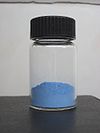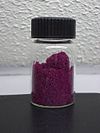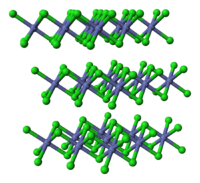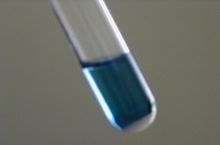- Cobalt(II) chloride
-
Cobalt(II) chloride 
Anhydrous
Hexahydrate Cobalt(II) chlorideOther namesCobaltous chloride
Cobalt(II) chlorideOther namesCobaltous chloride
Cobalt dichlorideIdentifiers CAS number 7646-79-9  ,
,
16544-92-6 (dihydrate)
7791-13-1 (hexahydrate)PubChem 24288 ChemSpider 22708 
UNII EVS87XF13W 
EC number 231-589-4 UN number 3288 ChEBI CHEBI:35696 
RTECS number GF9800000 Jmol-3D images Image 1 - Cl[Co]Cl
Properties Molecular formula CoCl2 Molar mass 129.839 g/mol (anhydrous)
165.87 g/mol (dihydrate)
237.93 g/mol (hexahydrate)Appearance rose red crystals (hexahydrate)
blue crystals (anhydrous)Density 3.356 g/cm3 (anhydrous)
2.48 g/cm3 (dihydrate)
1.92 g/cm3 (hexahydrate)Melting point 735 °C
Boiling point 1049 °C
Solubility in water 436 g/L (0 °C)
450 g/L (7 °C)
529 g/L (20 °C)Solubility soluble in acetone, ethanol, ether Structure Crystal structure CdCl2 structure Coordination
geometryOctahedral Hazards MSDS ICSC 0783 EU Index 027-004-00-5 EU classification Toxic (T)
Carc. Cat. 2
Dangerous for
the environment (N)R-phrases R49, R60, R22, R42/43, R68, R50/53 S-phrases S53, S45, S60, S61 NFPA 704 Flash point Non-flammable LD50 80 mg/kg Related compounds Other anions Cobalt(II) fluoride
Cobalt(II) bromide
Cobalt(II) iodideOther cations Rhodium(III) chloride
Iridium(III) chloride (verify) (what is:
(verify) (what is:  /
/ ?)
?)
Except where noted otherwise, data are given for materials in their standard state (at 25 °C, 100 kPa)Infobox references Cobalt(II) chloride is an inorganic compound of cobalt and chloride, with the formula CoCl2. It is usually supplied as the hexahydrate CoCl2·6H2O, which is one of the most commonly used cobalt compounds in the laboratory.[1] The hexahydrate is deep purple in color, whereas the anhydrous form is sky blue. Because of the ease of the hydration/dehydration reaction, and the resulting color change, cobalt chloride is used as an indicator for water in desiccants. Niche uses include its role in organic synthesis and electroplating objects with cobalt metal. Cobalt(II) chloride gives a blue-green color in a flame.
Contents
Properties
Aqueous solutions of both CoCl2 and the hydrate contain the species [Co(H2O)6]2+. In the solid state CoCl2·6H2O consists of the molecule trans-[CoCl2(H2O)4] and two molecules of water of crystallization.[2] This species dissolves readily in water and alcohol. Concentrated aqueous solutions are red at room temperature but become blue when heated.[3] CoCl2·6H2O is deliquescent and the anhydrous salt CoCl2 is hygroscopic, readily converting to the hydrate.
Preparation
Hydrated cobalt chloride is prepared from cobalt(II) hydroxide or cobalt(II) carbonate and hydrochloric acid:
- Co(OH)2 + 2 HCl → Co(H2O)6Cl2
Upon heating, the hexahydrate dehydrates in a stepwise manner.[4]
Reactions
Generally, aqueous solutions of cobalt(II) chlorides behave like other cobalt(II) salts since these solutions consist of the [Co(H2O)6]2+ ion regardless of the anion. Such solutions give a precipitate of CoS upon treatment with H2S. CoCl2·6H2O and CoCl2 are weak Lewis acids that react to give adducts that are usually either octahedral or tetrahedral. With pyridine (C5H5N), one obtains the octahedral complex:
- CoCl2·6H2O + 4 C5H5N → CoCl2(C5H5N)4 + 6 H2O
With the bulky ligand triphenylphosphine (P(C6H5)3), tetrahedral complexes result:
- CoCl2·6H2O + 2 P(C6H5)3 → CoCl2{P(C6H5)3}2 + 6 H2O
The anionic complex CoCl42–:[5]
- CoCl2 + 2 [(C2H5)4N]Cl → [(C2H5)4N)]2[CoCl4]
The [CoCl4]2- ion is the blue ion that forms upon addition of hydrochloric acid to aqueous solutions of hydrated cobalt chloride, which are pink.
 The structure of a cobalt(IV) coordination complex with the norbornyl anion.
The structure of a cobalt(IV) coordination complex with the norbornyl anion.
In the laboratory, cobalt(II) chloride serves as a common precursor to other cobalt compounds. Reaction of the anhydrous compound with sodium cyclopentadienide gives cobaltocene. This 19-electron species is a good reducing agent, being readily oxidised to the yellow 18-electron cobaltacenium cation. Reaction of 1-norbonyllithium with the CoCl2·THF in pentane produces the brown, thermally stable cobalt(IV) tetralkyl[6][7] — a rare example of a stable transition metal/saturated alkane compound,[1] different products are obtained in other solvents.[8]
Co(III) derivatives
In the presence of ammonia or amines, cobalt(II) is readily oxidised by atmospheric oxygen to give a variety of cobalt(III) complexes. For example, the presence of ammonia triggers the oxidation of cobalt(II) chloride to hexamminecobalt(III) chloride:
- 4 CoCl2·6H2O + 4 NH4Cl + 20 NH3 + O2 → 4 [Co(NH3)6]Cl3 + 26 H2O
The reaction is often performed in the presence of charcoal as a catalyst, or hydrogen peroxide is employed in place of air. Other highly basic ligands including carbonate, acetylacetonate, and oxalate induce the formation of Co(III) derivatives. Simple carboxylates and halides do not.
Unlike Co(II) complexes, Co(III) complexes are very slow to exchange ligands, so they are said to be kinetically inert. The German chemist Alfred Werner was awarded the Nobel prize in 1913 for his studies on a series of these cobalt(III) compounds, work that led to an understanding of the structures of such coordination compounds.
Instability of CoCl3
The existence of cobalt(III) chloride, CoCl3, is disputed, although it is listed in some compendia.[9] According to Greenwood and Earnshaw; excluding CoF3 the only stable binary compounds of cobalt and the halogens are the dihalides.[1] Stated differently, CoCl2 is unreactive toward Cl2[citation needed]. The stability of Co(III) in solution is considerably increased in the presence of ligands of greater Lewis basicity than chloride, such as amines.
Other uses
- Invisible ink
- Cobalt chloride is an established chemical inducer of hypoxia-like responses such as erythropoiesis. Cobalt supplementation is not banned and therefore would not be detected by current anti-doping testing.[10]
References
- ^ a b c Greenwood, Norman N.; Earnshaw, Alan (1997). Chemistry of the Elements (2nd ed.). Oxford: Butterworth-Heinemann. ISBN 0080379419.
- ^ Wells, A. F. (1984), Structural Inorganic Chemistry (5th ed.), Oxford: Clarendon Press, ISBN 0-19-855370-6
- ^ The Merck Index, 7th edition, Merck & Co, Rahway, New Jersey, USA, 1960.
- ^ John Dallas Donaldson, Detmar Beyersmann, "Cobalt and Cobalt Compounds" in Ullmann's Encyclopedia of Industrial Chemistry, Wiley-VCH, Weinheim, 2005. doi:10.1002/14356007.a07_281.pub2
- ^ Gill, N. S. and Taylor, F. B. (1967). "Tetrahalo Complexes of Dipositive Metals in the First Transition Series". Inorg. Synth. 9: 136–142. doi:10.1002/9780470132401.ch37.
- ^ Barton K. Bower and Howard G. Tennent (1972). "Transition metal bicyclo[2.2.1]hept-1-yls". J. Am. Chem. Soc. 94 (7): 2512–2514. doi:10.1021/ja00762a056.
- ^ Erin K. Byrne, Darrin S. Richeson and Klaus H. Theopold (1986). "Tetrakis(1-norbornyl)cobalt, a low spin tetrahedral complex of a first row transition metal". J. Chem. Soc., Chem. Commun. (19): 1491–1492. doi:10.1039/C39860001491.
- ^ Erin K. Byrne, Klaus H. Theopold (1989). "Synthesis, characterization, and electron-transfer reactivity of norbornyl complexes of cobalt in unusually high oxidation states". J. Am. Chem. Soc. 111 (11): 3887–3896. doi:10.1021/ja00193a021.
- ^ Handbook of Chemistry and Physics, 71st edition, CRC Press, Ann Arbor, Michigan, 1990.
- ^ . PMID 16244201.
External links
- International Chemical Safety Card 0783
- National Pollutant Inventory – Cobalt fact sheet
- IARC Monograph "Cobalt and Cobalt Compounds"
Cobalt compounds Categories:- Cobalt compounds
- Inorganic compounds
- Chlorides
- Metal halides
- IARC Group 2B carcinogens
- Deliquescent substances
Wikimedia Foundation. 2010.


